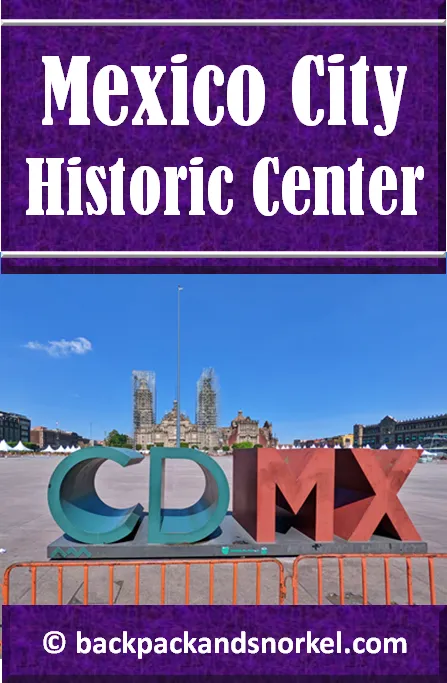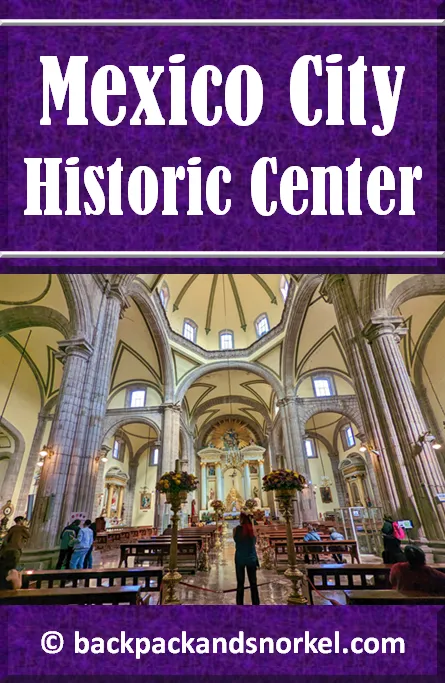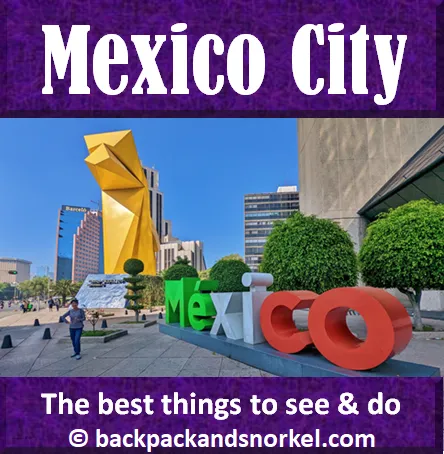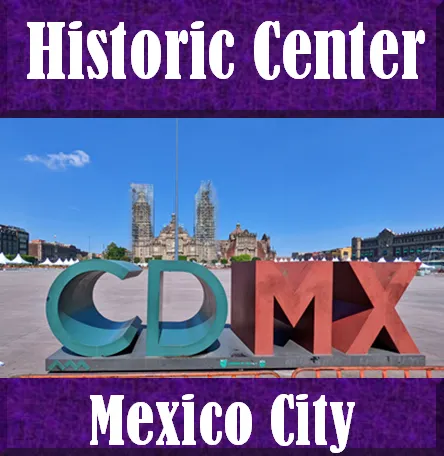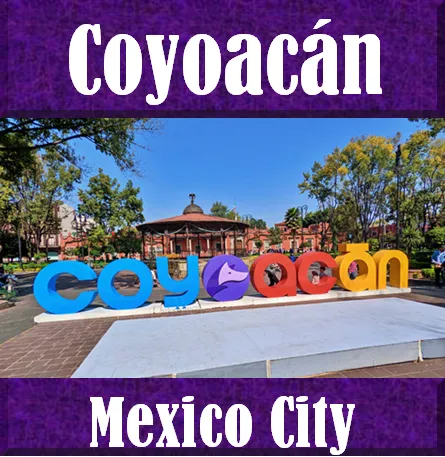Self-guided walking tour of the Historic District (Centro Histórico) in Cuauhtémoc in Mexico City - Mexico City Purple Travel Guide
The historic center is the most important tourist attraction of Mexico City. We provide you a detailed itinerary with the best things to see and we show lots of photos so you know what you can expect.
Cuauhtémoc is the historic and cultural center of Mexico City. It is named after the last Aztec Emperor and ruler of Tenochtitlan from 1520 to 1521.
It has the 6th largest population of all districts in Mexico City, but creates almost one third of the city's GDP. Mexico City’s historic district is part of Cuauhtémoc.
How to pronounce Cuauhtemoc?
Cuauhtémoc is pronounced: coo-au-tée-mock.
The ée in tée is pronounced as in fiancée and the stress is on tée.

A = Zócalo |
|
C = Palacio Nacional |
|
J = House of Tiles |
|
E = Templo Mayor |
K = Alameda Central |
Here at Backpack and Snorkel Travel Guides, we typically promote self-guided walking tours.
But we realize that not everybody likes to walk by themselves in a foreign city. So, just in case that you rather go with ab guide: NO PROBLEM! Please see the free GuruWalk and paid Viator tours below.
free GuruWalk tours
paid Viator tours
Zócalo
Start at Zócalo, which is officially named Plaza de la Constitución and one of the largest plazas in the world.
Nowadays, Zocalo is bordered by Catedral Metropolitana de la Ciudad de México (Mexico City Metropolitan Cathedral) in the north, Palacio Nacional (National Palace) in the east, the Old Portal de Mercaderes to the west, Mexico City administrative buildings in the south and Templo Major to the northeast. In Aztec times, Moctezuma II's Palace stood to the east, the palace of Axayacatl to the west and the sacred precinct which, according to Aztec belief, was the center of the city and the universe, to the north and northeast.
After Cortés conquered and razed the city of Tenochtitlan, he built a church to the north (now Mexico City Metropolitan Cathedral), a palace for himself in the east (now National Palace), Portales de Mercaderes (Merchants' Portals) to the west and to the south, he built the House of the Ayuntamiento, which was a government building (now Mexico City administrative buildings).
Throughout its history, Zócalo has been used as a marketplace, a place for political demonstrations, parades, and non-political events like concerts.
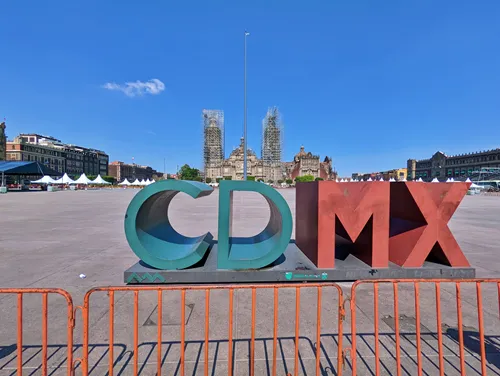
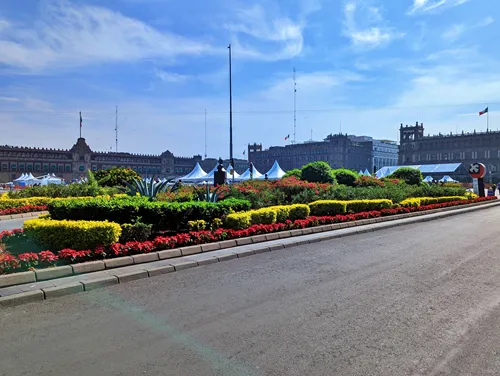
Tourists may be most interested in the beautiful architecture of the surrounding buildings, the many restaurants and shopping places and the CDMX sign at the southern tip of the plaza.
Gran Hotel Ciudad de Mexico
The Gran Hotel is not visible from Zocalo – the hotel that you see from Zocalo is the Majestic Hotel. The Gran Hotel entrance is located on the road: 16 de Septiembre.
While the buildings facing the Zocalo had to have neocolonial facades, the architects of the original Mercantile Center (department store), which is now the Gran Hotel, were free to use the Neoclassical style which was seen as more modern in 1899 when it was built.
The lavish Art Nouveau style of the interior of the Gran Hotel has not changed much since 1899, when it was a department store. And, yes, the elevators and the stained-glass ceiling, which was designed by French woodworker and glass artist Jacques Grüber, are all originals.
In 1968, the building was converted into a hotel to accommodate people who were attending the 1968 Summer Olympic games.
The hotel was used in multiple films, including the James Bond movies License to Kill (1989) and Spectre (2015).
Go up the stairs into the hotel lobby and marvel at the grandiose stained-glass ceiling, elevators, architectural detail of the walls and the beautiful chandelier above the stairs.
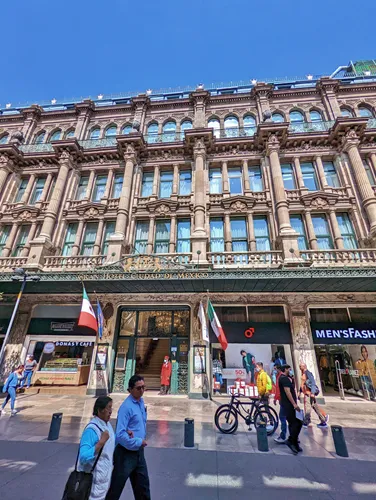
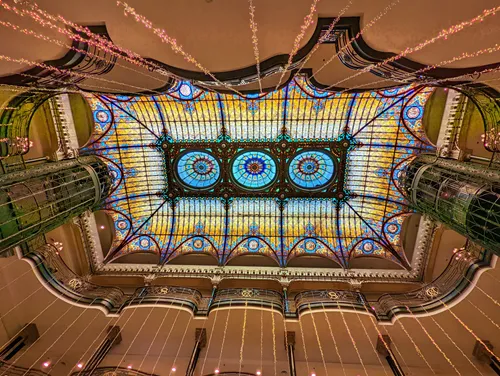


Palacio Nacional
Palacio Nacional is the seat of the federal executive in Mexico and, since 2018, the official residence for the President of Mexico. That is the reason why the palace is currently not open for tourists.
When the palace was built, many of the building materials were reused from the ruins of Moctezuma II palace that used to stand on the same place.
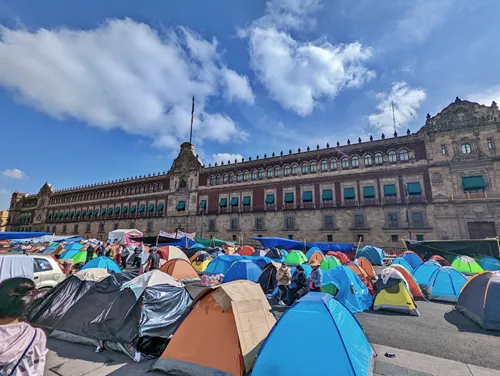
Facing Zocalo, the palace has three doorways. Notable is the balcony above the central doorway. Here, the president of Mexico rings the bell that hangs above the balcony as part of the Grito de Dolores celebration just before 11pm on September 15. The Grito Dolores, or the Cry of Dolores, was when Catholic priest Miguel Hidalgo y Costilla rang his church bell as the call to arms that initiated the Mexican War of Independence.
Mexico City Metropolitan Cathedral
The original Spanish church that was built on the grounds where the cathedral stands today, was built on top of ruins of what was likely a major Aztec temple dedicated to the god Quetzalcoatl and some other buildings near the Templo Mayor.
It was soon considered insufficient for the growing in importance of the city, but it was still elevated to the rank of a cathedral in 1534.
Inspired by Gothic cathedrals in Spain, Mexico City Metropolitan Cathedral was built from 1573 to 1813. The first stone was, however, placed in 1571, but construction started in 1573. Because the terrain was muddy and unstable, special precautions had to be taken and it took until 1581 until the first walls were erected.
Over the long construction time of 240 years, architectural preferences changed and led to the inclusion of Baroque, Neoclassical, and other styles.
Consecration of the unfinished church was in 1656 and a second dedication was held in 1667 after the last vault was closed.
Mexico City Metropolitan Cathedral is the short form of Metropolitan Cathedral of the Assumption of the Most Blessed Virgin Mary into Heaven (Catedral Metropolitana de la Asunción de la Bienaventurada Virgen María a los cielos). It is the cathedral church of the Roman Catholic Archdiocese of Mexico and, due to the importance of the catholic church in Mexico and New Spain, it was often the scene of historically significant events like various coronations and burials of emperors and independence heroes.
The cathedral is facing south towards Zocalo, and it is 420 ft (128 m) long and 194 ft (59 m) wide. It has two bell towers that are 220ft (67m) tall and contain 25 bells.
Of the 16 chapels in the cathedral, 14 are open to the public. Each chapel was sponsored by a confraternity and is dedicated to a one or more saint or saints.
There are five naves, 51 vaults, 74 arches and 40 columns.
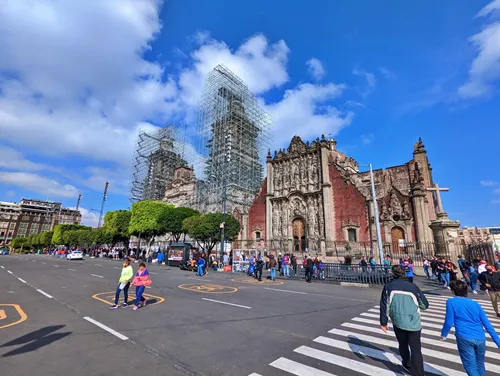
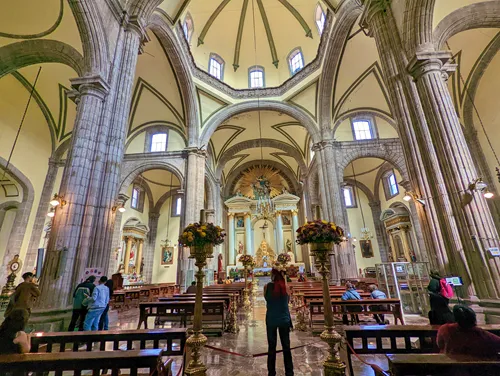
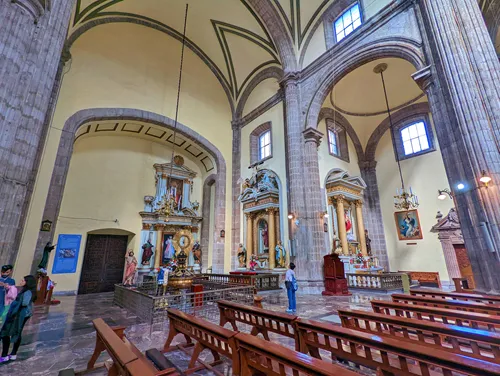

Templo Mayor
Templo Mayor was called Huēyi Teōcalli by the Aztecs and for them, Huēyi Teōcalli was the center of the city Tenochtitlan, which is now Mexico City, and the center of their universe.
Templo Mayor was dedicated to two gods:
- Huitzilopochtli: the god of war, sun, human sacrifice, and the patron of the city of Tenochtitlan
- Tlaloc: the god of rain, water, fertility, and agriculture
Both deities had separate shrines at the top of the great pyramid and there was a separate staircase for each shrine. The shrine of Huitzilopochtli was the larger of the two.
The central spire was dedicated to the wind god Quetzalcoatl.
The great pyramid is estimated to have had this size at the base: 328 x 262 ft (100 x 80 m) and measured 200 ft (60 m) from the plaza to the top of the Huitzilopochtli shrine.
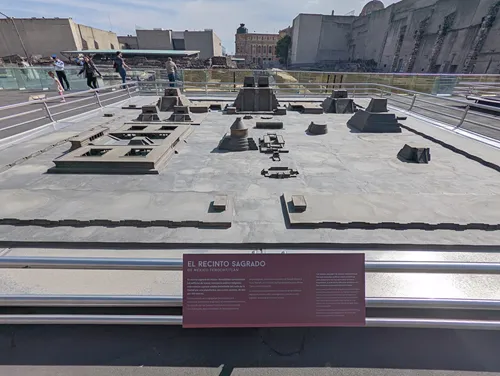
When Cortes conquered and destroyed Tenochtitlan in 1521, he used building materials from Templo Mayor to rebuild Mexico City in Spanish style.
While much of Templo Mayor was destroyed, some of it became overgrown by vegetation and was eventually forgotten. Over time, people started settling in this area and build their houses without knowing that one of the Aztecs holiest sites lay buried underneath them.
In the late 19th and early-to-mid 20th century, excavations found parts of buildings and artefacts, but it took until 1978 when buildings on this site were demolished and serious excavation and preservation work was started.
The excavated buildings with some limited explanations can be seen free of charge from an elevated walkway.
The artefacts that were found can only be seen in the Templo Mayor Museum.
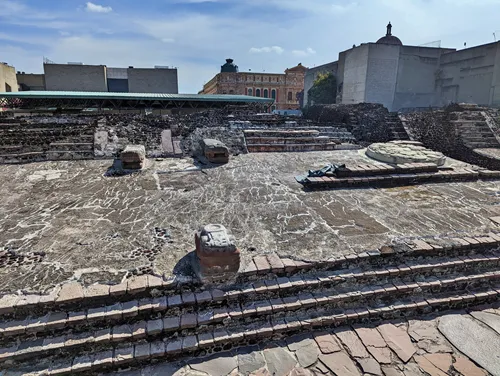
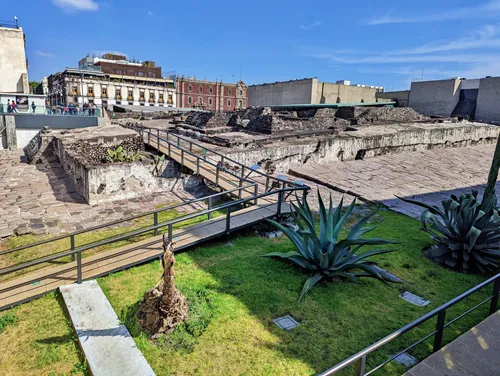
Templo Mayor, the great pyramid, was built in seven phases. Each phase was building upon and enlarging the temple of the previous phase.

- First Temple: Construction of the first temple started around 1325. It is immersed in ground water and can therefore not be excavated. Ancient records state that this first pyramid was built with earth and wood, and it is doubtful that any of this will have survived until now. The first temple is the only unexcavated phase.
- Second Temple: The second temple was built between 1375 and 1427, during the reigns of kings Acamapichtli, Huitzilihuitl and Chimalpopoca. So far, only the upper part of this temple with its two stucco-covered stone shrines has been excavated.
- Third Temple: The third temple was built between 1427 and 1440 during the reign of king Itzcoatl. It contained a staircase with eight stone standard-bearers (divine warriors) that guard the access to the upper shrines on the pyramid.
- Fourth Temple: This temple was built between 1440 and 1481 during the reigns of kings Moctezuma I and Axayacatl. Its top platform was decorated with serpents and monkey or Tlaloc shaped braziers.
- Fifth Temple: The fifth temple was built between 1481 and 1486 during the reign of king Tizoc.
- Sixth Temple: The sixth temple was built between 1486 and 1502 during the reign of king Ahuizotl. During his reign, the Sacred Precinct was surrounded by a wall that was decorated with serpent heads, three shrines and the House of the Eagle Warriors were built.
- Seventh Temple: The seventh temple was almost completely destroyed by the Spaniards and almost all of what we know about this temple is comes from historical records. Only one platform in the north and a section of paving in the courtyard on the south side have survived.
The seventh temple was the largest and most important ceremonial center of the Aztecs. It measured at the base: 328 x 262 ft (100 x 80 m) and was 200 ft (60 m) tall from the plaza to the top of the shrine of god Huitzilopochtli.
Looking from the main plaza in front of the great pyramid, the left shrine was dedicated to the water god Tlaloc and the right shrine was dedicated to the god of the sun and war, Huitzilopochtli.
There were two separate stairways on the front that gave access the great platform on which the two shrines stood. Each shrine had large braziers where sacred fires continuously burned. The entire pyramid was covered with stucco and covered with colorful paint.
Cortes reported that he and was impressed by the number and magnificence of the temples he saw in Tenochtitlan. Unfortunately, that only fueled his fanatic desire to destroy all non-Christian religious symbols.
Templo Mayor Museum
The museum was built in 1987 to house the artefacts that were found excavating Templo Mayor. It has 8 exhibit halls, and each room is dedicated to a deity or a topic like agriculture.
If you plan to visit the museum, be advised that they do not allow you to bring any liquids into the museum and there are no lockers where you can store them. You will either need to discard all your drinks or leave them near the trash can outside the museum, hoping that they will still be there when you come back.
If that is not acceptable to you, don’t despair. You can see lots of similar artefacts at the Museo Nacional de Antropología.
The eight exhibit rooms are:
- Room 1: This hall is dedicated to artefacts found at Templo Mayor relating to Coatlicue (mother of god Huitzlipochtli) and Coyolxauhqui (Huitzlipochtli’s sister).
- Room 2: This hall displays artefacts that are related to the concepts of ritual and sacrifice in Tenochtitlan. Here you can see funerary offerings, knives, musical instruments, skulls, and urns.
- Room 3: In this hall you will find artefacts related to the economy of the Aztec empire.
- Room 4: This hall is dedicated to the artefacts related to the god Huitzilopochtli.
- Room 5: This hall is dedicated to the god Tlaloc.
- Room 6: This hall is dedicated to the flora and fauna of Mesoamerica and their divine meanings to the Aztecs.
- Room 7: In this hall, you will learn about the agricultural technology of the Aztecs.
- Room 8: This hall is dedicated to the history and archeological investigation of Templo Mayor.
Museo Nacional de Arte
The Museo Nacional de Arte, often just called MUNAL, was founded in 1982. It is located in the old Palace of Communications, which was built in the early 20th century to house the Secretariat of Communications and Public Works.
MUNAL’s permanent collection consists of more than 3,000 pieces of Mexican fine art from the colonial period (1550 to 1821), the first century after Mexico’s independence (1821 to about 1920) and the period after the Mexican Revolution (1920 to 1950).
Besides the artwork, visitors can enjoy the beautiful architecture of the palace, which is primarily designed in Classic and Gothic styles, but other architectural styles can also be found.
Admission is 80 Pesos per person and payment is only accepted in cash. If you want to take photos (no flash photography allowed), then you have to pay 5 Pesos extra and you will receive a rolled-up paper ticket that you will have to wear as a ring to signal the guards that you paid.
Video permits cost 30 Pesos. Tripods or illumination are not permitted.

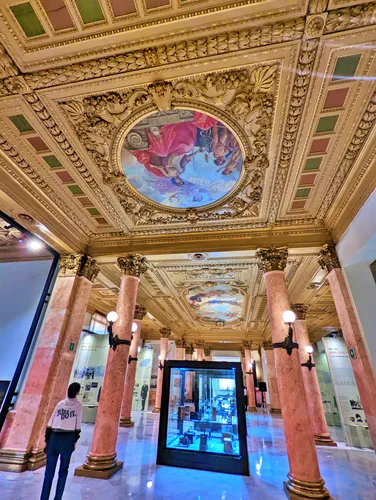

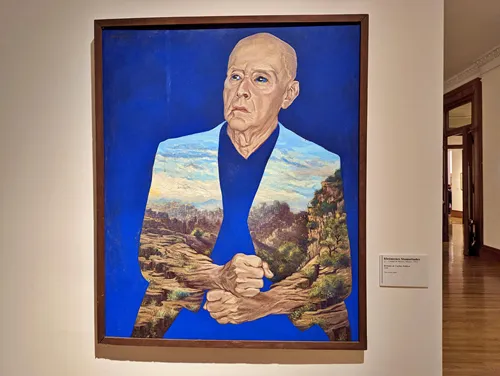
Palacio Postal
Palacio Postal is also known as Palacio de Correos de México, the main post office. It sits in a gorgeous building that was constructed in 1907 and was hailed as the most modern post office at that time.
A botched renovation in the 1950s weakened the building significantly and the magnitude 8 earthquake in 1985 resulted in severe damage. About 5 years later, construction started to restore the building to its original construction and appearance. The result is phenomenal.
The northern part of the building which can be accessed from Calle de Tacuba houses the Museo Postal which is definitely worth the 10-15 minutes that you will need to browse through the exhibits. The second floor can currently not be accessed.
Make sure to take a close look at the architectural detail.
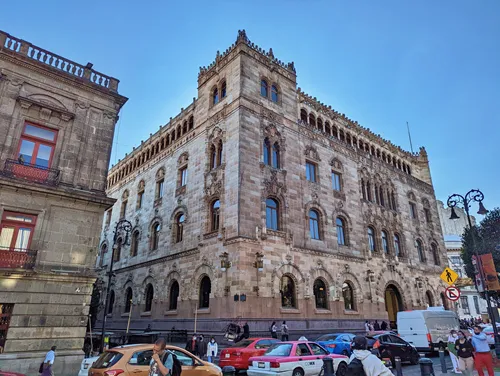

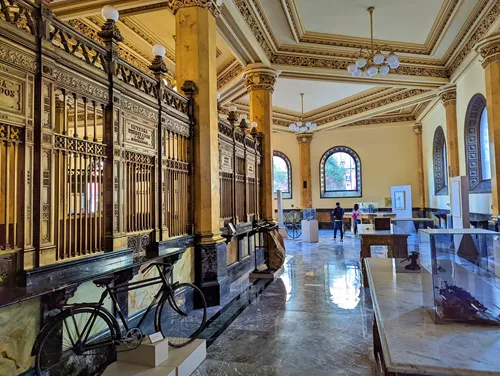
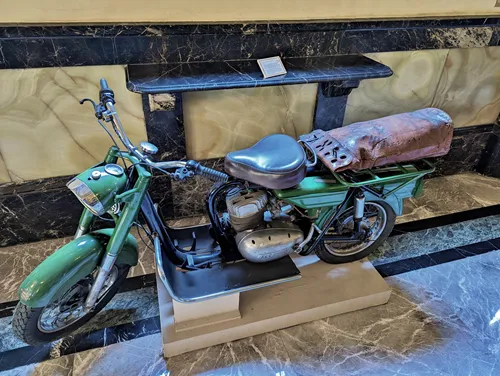
The main post office can be accessed the main entrance at the intersection of Eje Central Lazaro Cardenas and Calle de Tacuba.
If you want to send a postcard or letter to your friends or loved ones, this is probably the best place to do it. Postcards are available from vendors in front of the post office or from nearby Casa de los Azulejos (House of Tiles).

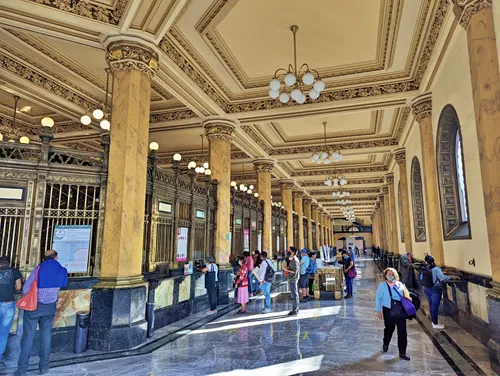
Palacio de Bellas Artes
Mexico City’s Palace of Fine Arts is sometimes called Mexico’s Cathedral of Art, because it has hosted many most notable concert, dance, literature, opera, and theater events and exhibitions of paintings, photography, and sculptures. In 1987, it was declared an artistic monument by UNESCO.
The Palacio de Belles Artes was built from 1904 - 1934 with multiple delays and construction stops.
The building itself is impressive in its Art Nouveau (exterior) and Art Deco (interior) styles. The main exterior and interior façades are made of white Italian Carrara marble. The four Pegasus sculptures in the plaza front of the building were brought here from the Zocalo where they originally stood.
Today, the museum exhibits murals, paintings, and sculptures on three floors. It is notable for its (often violent) murals by Diego Rivera and other renowned Mexican artists. Compared to other museums, the amount of exhibited art is much lower.
Admission is 80 Pesos per person, only cash is accepted. Bags need to be checked for free at the wardrobe.

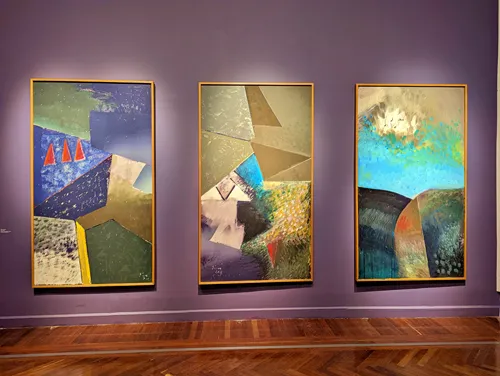


Torre Latinoamericana
Built from 1949-1956, Torre Latinoamericana was Mexico's tallest completed building until 1982 and it was the world's first major skyscraper that was successfully built in a highly active seismic zone. It withstood the destructive 7.9 magnitude earthquake in 1957 and the 8.1 magnitude earthquake in 1985 without damage.
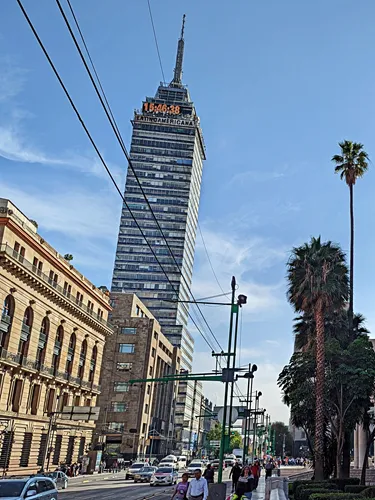
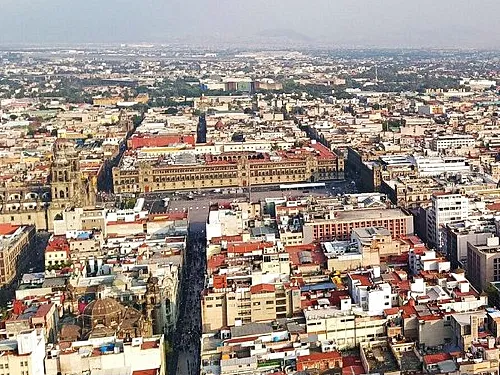
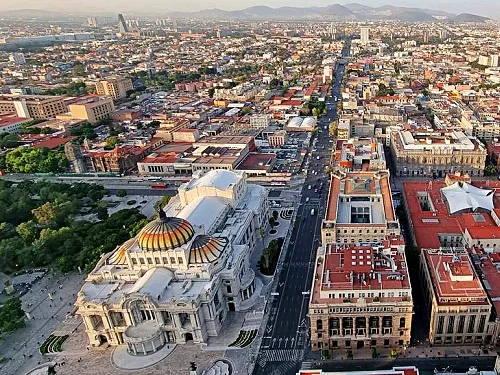
House of Tiles (Casa de los Azulejos)
Built in the 16th century from two existing mansions that were separated by an alley were combined by the Counts of the Valley of Orizaba, earning it the nickname Palacio de los Condes del Valle de Orizaba.
One of the descendants, Doña Graciana Suárez de Peredo, the Fifth Countess of the Valley of Orizaba, ordered the façade tiled in 1737 with handmade tiles from Puebla.
The Counts of the Valley of Orizaba sold the mansion in 1871 and it changed owners several times.
In 1917, the building was acquired by the Sanborn brothers who renovated it and transformed it into a restaurant. Today, this restaurant is the flagship restaurant of the Sanborns chain.
In 1931, Casa de los Azulejos was declared a national monument.
Even if you don’t want to eat here, go inside and take a look at the beautifully decorated and painted dining room and maybe you find some pralines or other candy that you like.
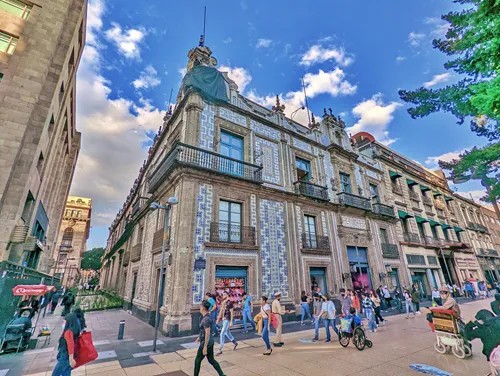
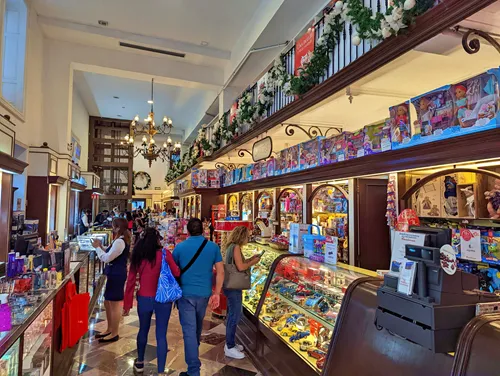
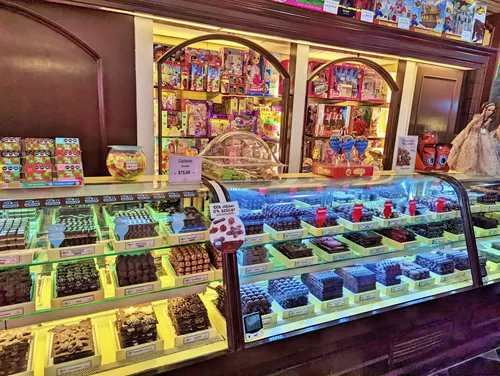

Alameda Central
Built in 1592 on the site of an Aztec marketplace, Alameda Central is the oldest public park in the Americas. It is a symbol of a traditional Mexican park that has inspired many other cities in Mexico to name their parks Alameda, too.
The western parts of the park were added in 1770 and 1791 and the layout you see today dates back to the late 19th and early 20th century.
After Mexico gained its independence in 1821, President Santa Anna ordered the fountains in the park be filled with alcohol.
Alameda Central is notable for its fountains and statues:
- Beethoven Monument
- Benito Juárez Hemicycle (grandest monument, built in 1910)
- Désespoire
- Fountain of Mercury
- Fountain of Neptune
- Fountain of Venus
- Fountain of Virgin (central fountain)
- Gladiador frigio
- Gladiador romano
- La Primavera
- Las Danaides
- Malgré Tout
- Statue of Alexander von Humboldt

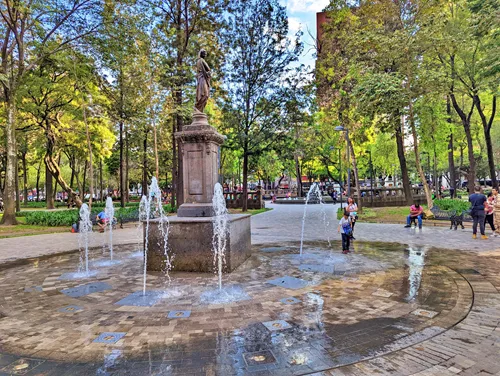


Murals and monuments at Paseo de la Reforma
Your last stop of today is Paseo de la Reforma, which is the Mexican version of the Champs-Élysées in Paris or the Ringstraße in Vienna.
If you talk to locals, you will find that they often shorten Paseo de la Reforma to Reforma.
Paseo de la Reforma is a 9.1 mile (14.7km) long boulevard that connects the National Palace with Chapultepec Castle. the imperial residence. It was built during the short-lived Second Mexican Empire from 1864–1867 and improved many times in the following years, notably with trees, bridges and monuments which were not part of the original build.
The last major overhaul was the Renewal Project in 2003, which converted Paseo de la Reforma into one of the major attractions of Mexico City and sent land prices skyrocketing, making it the most expensive area in Mexico City.
Walk along Paseo de la Reforma and enjoy the monuments, murals and statues that stand every feed hundred feet along the street.
Some notable sights in the area where you are now are:
- Torre Caballito and the nearby Mexico sign
- Fontán Reforma Hotel with its murals
- Iglesia de San Hipólito y San Casiano
- The many statues along the street
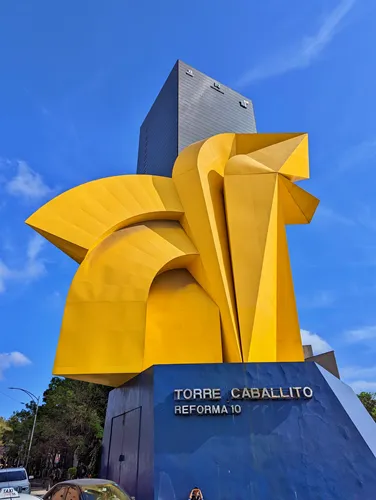

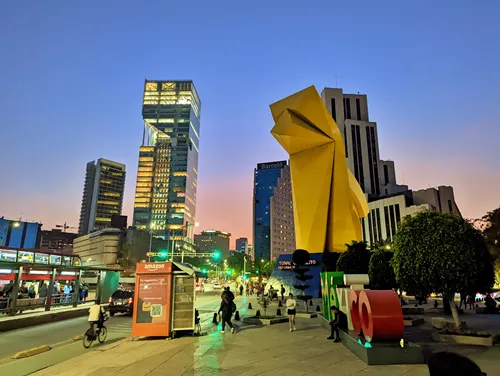
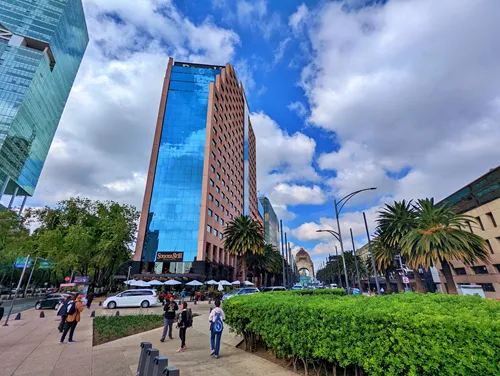

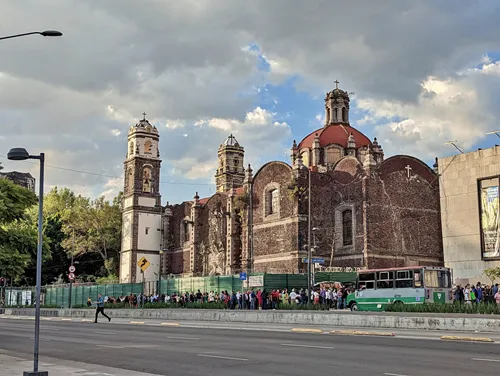
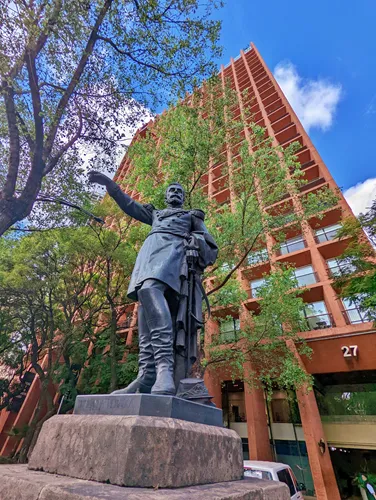
You will find lots of expensive and inexpensive restaurants on Paseo de la Reforma and if you explore the side streets in the afternoon, you will find lots of street vendors making delicious and often very inexpensive food. They are fun to see during daytime, but they really come to life in the evening as night food markets. Instead of finding a restaurant, we typically just at dinner at one or two of these street food stands.

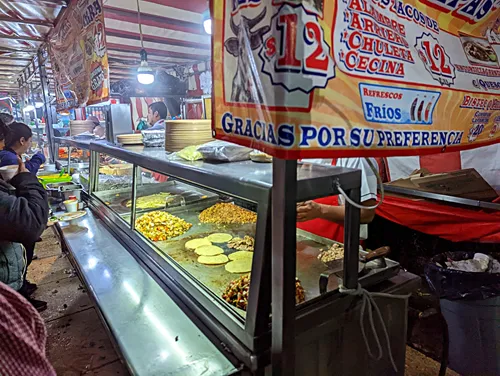
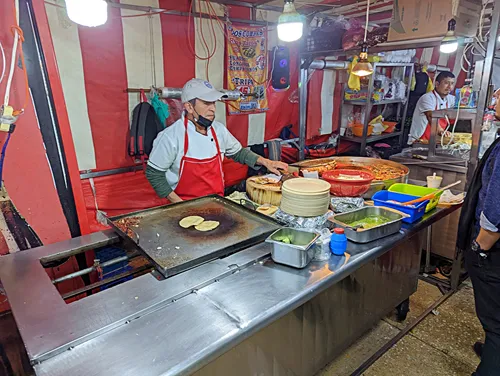
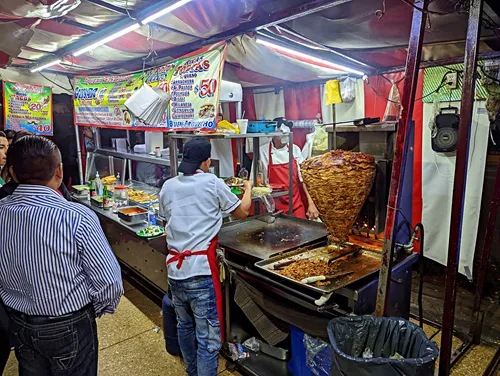
Paseo de la Reforma has become a preferred place for Mexicans to hold celebrations or demonstrations.
On one weekend we witnessed three parades right in front of our Airbnb on Paseo de la Reforma. Two were short, but one lasted for 90min after we arrived, and we don’t know how long it was already underway.

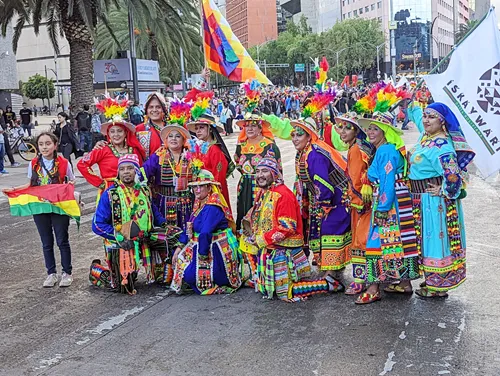

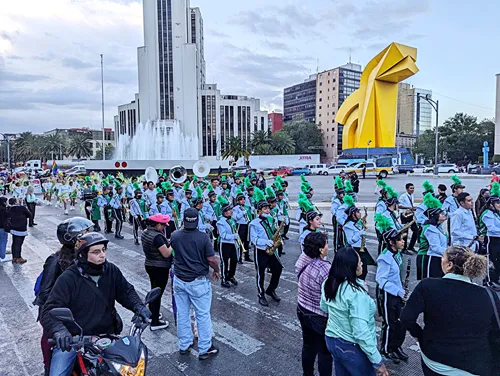
This concludes your first full day in Mexico City.
Self-guided walking tours of Mexico City
Author: Rudy at Backpack and Snorkel
Bio: Owner of Backpack and Snorkel Travel Guides. We create in-depth guides to help you plan unforgettable vacations around the world.
Other popular Purple Travel Guides you may be interested in:
Like this Backpack and Snorkel Purple Travel Guide? Pin these for later:
